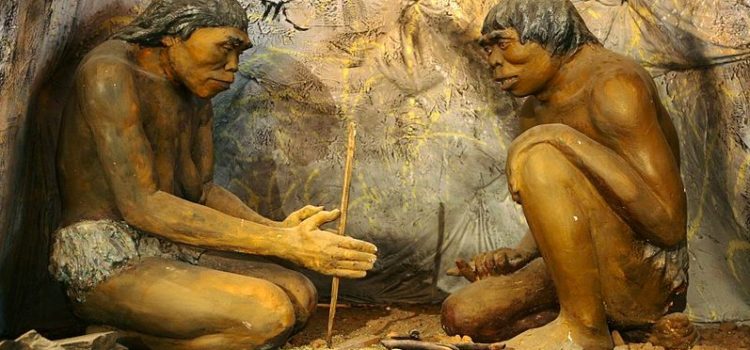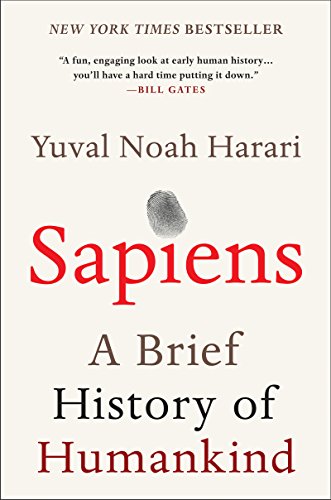

This article is an excerpt from the Shortform summary of "Sapiens: A Brief History of Humankind" by Yuval Noah Harari. Shortform has the world's best summaries of books you should be reading.
Like this article? Sign up for a free trial here .
How did early humans communicate with each other? What features of Homo sapiens language made this species successful?
Early humans communicated through complex language, gossip, and shared fictions. These advancements in language allowed our species to dominate the animal kingdom, and the later invention of writing allowed people to leave a written legacy.
We’ll cover why linguistic advancements such as gossip were such an important form of communication for early humans, and we’ll look at how writing was invented.
Early Human Communication
2.5 million years ago, Homo sapiens was just one of eight human species. The first major revolution for Sapiens was the Cognitive Revolution 70,000 years ago. Before that point, Sapiens weren’t particularly special and weren’t superior to the other seven human species. The Cognitive Revolution involved the development of three new abilities, all related to language, that helped Homo sapiens outpace their fellow humans.
These early human communication skills would be essential to the later creation of the modern world.
How Did Early Humans Communicate With Each Other?
Through Flexible Language
Early human communication was flexible. One reason the language of Sapiens was different was that it was more complex. Rather than communicating simple ideas the way green monkeys do (“Careful! A lion!” or “Careful! An eagle!”), the language of Sapiens could warn someone about a lion, describe its location, and plan how to deal with it. This allowed them to plan and follow through on complex actions like avoiding predators and working together to trap prey.
Through Gossip
Another way early humans communicated with each other? Gossip. We think of gossip as a bad thing, but using language to convey information about other people is a way to build trust. Trust is critical for social cooperation, and cooperation gives you an advantage in the struggle to survive and pass on your genes. Sapiens could form groups of up to 150 people. They didn’t need to know every group member personally to trust them. In a battle, a small group of Neanderthals was no match for a group of 150 Sapiens.
Through Fictions
A third benefit of the Sapiens’ language was how it was used to create fictions, also known as “social constructs” or “imagined realities.” This was another important aspect in the answer to the question, How did early humans communicate with each other?
Being able to communicate information about things that don’t exist doesn’t seem like an advantage. But Sapiens seem to be the only animals who have this ability to discuss things that don’t have a physical presence in the world, like money, human rights, corporations, and God.
Collective Fictions
In and of itself, imagining things that don’t exist isn’t an asset—you won’t aid your chances of survival if you go into the forest looking for ghosts rather than berries and deer.
What’s important about the ability to create fictions is the ability to create collective fictions, fictions everyone believes. These collective myths allow people who’ve never met and otherwise would have nothing in common to cooperate under shared assumptions and goals.
Early Communication: The Invention of Writing
Later, early humans communicated through writing.
The social orders and cooperative systems of some species are maintained because the information for their maintenance is encoded in their DNA. For example, the behavior that makes a female bee fulfill her role as either a worker or queen is programmed into her genes.
But imagined systems aren’t encoded in our DNA, so we have to memorize the roles and behaviors they require. This worked for Sapiens for a while, but our systems became complex and required more information than one brain could hold.
The solution was writing. Although today we connect the word “writing” with “literature,” early writing was used to record tax payments, debts, and property ownership, not to write poems and stories. Writing also wasn’t invented to record spoken language. It was invented to fill a gap, to succeed where spoken language failed. It was needed to record data.
The Sumerians invented writing in southern Mesopotamia between 3500 BC and 3000 BC. Eventually, the Sumerians wanted to record more than just mathematical data, so they gradually added signs to their script, which developed into a script capable of representing spoken language. We call it cuneiform.
People who weren’t accountants started writing. Kings used cuneiform to give orders, priests used it to write down oracles, and citizens wrote letters. Also around 2500 BC, the Egyptians developed hieroglyphics. Soon after, societies in China and Central America developed full scripts.
Arabic Numerals
A huge advance in the written form was the invention of the signs representing 0 to 9, invented by the Hindus but refined and circulated by the Arabs. We call them Arabic numerals. This was the foundation of the mathematical notation we use today.
This is a partial script (it can’t record spoken language), but that hasn’t stopped it from being the most used language in the world. No matter what language a country speaks, almost everyone speaks the language of mathematics.
Mathematical script increased the efficiency of recording, processing, and transmitting data, and it broadened the capacity of the human potential. Even today, advanced written script can lead to new human capabilities. For instance, most brains can’t comprehend the details of quantum mechanics because they aren’t wired to do so. But physicists can because they’ve retrained their brains to think less like humans and more like computers, and they have the aid of processing systems like mathematical script. Much of their “thought process” takes place outside of their heads, on a chalkboard or a computer.
How did early humans communicate with each other? Through complex language, long before the invention of writing.
———End of Preview———

Like what you just read? Read the rest of the world's best summary of "Sapiens" at Shortform . Learn the book's critical concepts in 20 minutes or less .
Here's what you'll find in our full Sapiens summary :
- How Sapiens outlived and outlasted the 8+ other human-like species on Earth
- The 3 critical revolutions in human existence that led to our domination of the planet
- How much of what powers our world today is really just a shared mass delusion
- What the future of humanity might look like






